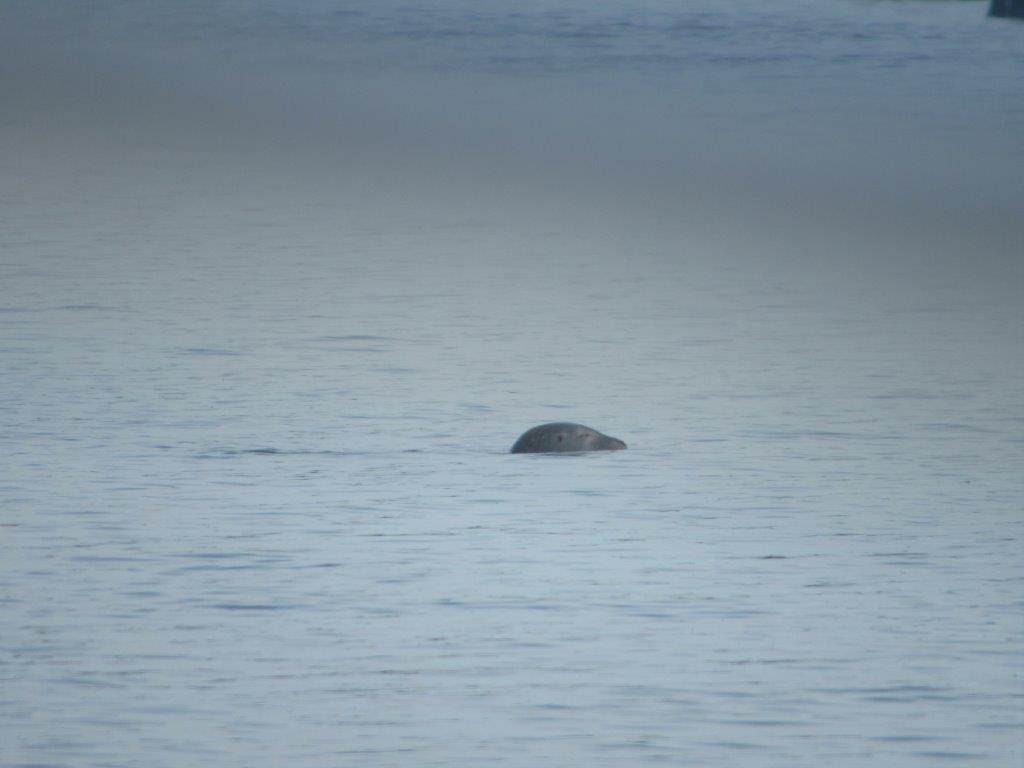Historical News
Water Column Profiles
R/V Monitor's Blog
On Wednesday, August 19th, the crew of the R/V Monitor was out on the upper Bay collecting bacteria samples, taking Secchi Disk water clarity measurements, conducting water column profiles using a profiling sonde, and conducting real-time surface mapping of water quality parameters, including dissolved oxygen, chlorophyll, water temperature, salinity, and pH, all in an effort to document water quality improvements associated with NBC construction projects. In the afternoon the temporary buoy located in Pawtuxet Cove was serviced, a water profile was performed, and a chlorophyll sample was collected at the buoy. Jeff captained the boat while monitoring professionals Fern and Daryll collected the samples and data, and servided the buoy. It was a warm and sunny day with no wind in the morning. The wind picked-up out of the southwest in the afternoon but the waters remained calm all day. The photo below taken at the Gano Street boat ramp shows some paddleboarders enjoying the fine weather.

Nutrients Sampling
Riverine nitrogen concentrations were greatest at the Pawtuxet River at Broad Street location, with total nitrogen (TN), total dissolved nitrogen (TDN), and dissolved inorganic nitrogen (DIN) measuring 2,300 ppb, 2,460 ppb, and 1,1886 ppb, respectively. Lowest riverine nitrogen concentrations occurred at the Ten Mile River at Roger Williams Ave. location, where TN was 561 ppb, TDN was 614 ppb, and DIN was 174 ppb.
Among the bay stations sampled, the highest surface nitrogen concentrations were observed at Pawtuxet Cove, where TN was 1,640 ppb, TDN was 1,530 ppb, and DIN was 1,198 ppb. Lowest TN occurred at Edgewood Yacht Club, which had a reported value of 520 ppb (average of duplicates). Surface TDN and DIN concentrations were lowest at Conimicut Point, with concentrations of 206 ppb and 13 ppb, respectively.
Results from sampling on July 29 and August 13 are pending analysis.
Fixed Site Network
Phillipsdale Landing
Water quality was fair this week at Phillipsdale Landing. Sondes were changed out for maintenance on the morning of August 4. Approximately 0.19 inches of rainfall was recorded in a mostly dry week, all of which occurred on August 4. Overall, surface salinity at the site remained steady throughout the week, with a slight increasing trend in the bottom waters. For the week, surface salinity averaged 19.9 ppt (range 8.9 – 24.5 ppt) while bottom salinity averaged 23.5 ppt (range 12.2 – 27.7 ppt). Surface water temperatures decreased slightly since the previous week; surface temperatures ranged from 24.8°C to 28.7°C and averaged 26.9°C, while bottom temperatures increased slightly this week ranging from 25.6°C to 27.8°C and averaging 26.7°C. Dissolved oxygen (DO) concentrations were hypoxic (<2.9 mg/L) in both surface and bottom waters for a portion of the week. Surface water DO averaged 7.1 mg/L with a minimum of 2.6 mg/L occurring in the morning of August 4. Bottom water DO improved slightly compared to the previous week, averaging 3.9 mg/L with a minimum of 1.2 mg/L; bottom waters were hypoxic for 26% of the week. Surface chlorophyll decreased this week compared to last, averaging 51.9 ug/L with a maximum of 88.8 ug/L occurring on August 2.
Bullock Reach
The bottom sonde that was deployed on July 28 exhibited signs of excessive drift due to a malfunctioning conductivity sensor. The bottom sonde conductivity sensor was replaced in the morning of August 4 and all salinity data before the sensor was replaced have been excluded from the following summary. Overall water quality was good this week. Surface salinity increased slightly from the previous week, averaging 28.3 ppt and ranging from 24.8 – 29.8 ppt. Salinity at the mid and bottom waters averaged 29.3 ppt and 31.1 ppt, respectively. Water temperatures also increased slightly this week, averaging 26.3°C at the surface, 26.0°C at the mid-depth, and 25.2°C at the bottom. Hypoxia was not evident in the surface and mid waters; surface waters averaged 6.5 mg/L with a minimum of 4.5 mg/L, while mid depth waters averaged 5.4 mg/L with a minimum of 3.0 mg/L. Hypoxia was observed only in the bottom waters, averaging 4.4 mg/L with a minimum of 1.7 mg/L; bottom hypoxia only occurred periodically on August 2. Please note that calculations of DO in mg/L utilizes information from the conductivity probe and as a result of the drift in the probe, bottom DO readings may have been impacted prior to the probe being replaced. Surface chlorophyll decreased slightly this week, averaging 10.6 ug/L and reaching a maximum of 85.6 ug/L in the afternoon of August 8. Mid-depth chlorophyll averaged 9.5 ug/L, while bottom chlorophyll averaged 7.4 ug/L.
R/V Monitor's Blog
The R/V Monitor was out on the upper Bay twice this week. First, on Wednesday, August 12th, the crew of the R/V Monitor was out at NBC's Bullock's Reach buoy to perform routine maintenance and change out the sondes. Sara captained the boat while monitoring professionals Fern and Steve conducted the buoy work. It was a partly sunny, hot and humid day with a light breeze out of the west. On Thursday, August 13th, the crew was out collecting nutrients samples, taking Secchi Disk water clarity measurements, conducting water column profiles using a profiling sonde, and conducting real-time surface mapping of water quality parameters, including dissolved oxygen, chlorophyll, water temperature, salinity, and pH, all in an effort to document water quality improvements associated with NBC construction projects. Sara captained the boat while monitoring professionals Amanda and Steve collected the samples and data. It was a wonderful day on the Bay with a cloudy start but clearing to partial sun. The water was very calm despite a breeze out of the northwest turning southwest by the afternoon. A seal spotted in the Seekonk River by Phillipsdale landing is featured in the below photo.




